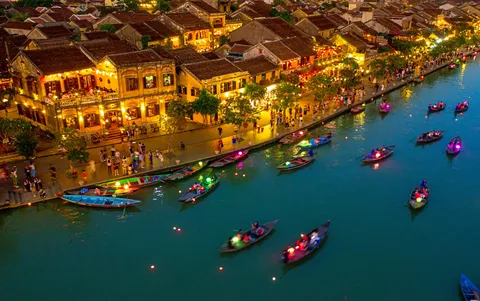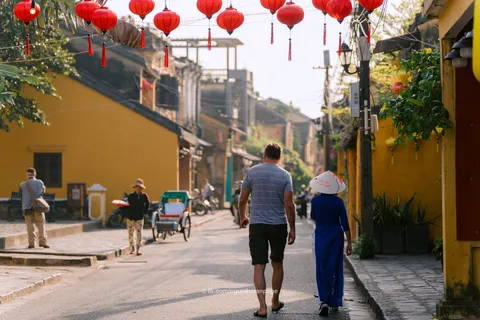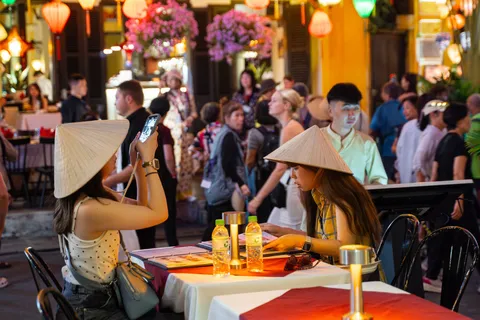Hoi An Ancient Town
Hoi An is one of the most famous tourist destinations in Central Vietnam that attracts not only domestic tourists but also tourists from all over the continents
Introduction about Hoi An ancient town is located, in which province?
Hoi An is one of the most famous tourist destinations in Central Vietnam that attracts not only domestic tourists but also tourists from all over the continents. This is an ancient town in the eastern coastal region of Quang Nam province, with a total natural area of about 63.66 km2. It is located in the lower Thu Bon River, about 30 km southwest of Da Nang city center and about 40 km from My Son Sanctuary.
Hoi An has both a sea and an island, possessing a quite convenient location. This has created ecological and geographical diversity. The land area is about 46.22 km2 bordering Duy Xuyen district to the south, to the west and north to Dien Ban, to the east to the coast about 7 km long. The island area of about 15 km is Cu Lao Cham Island.
Many old quarters were built in the 16th century, which still exist almost intact. Since being recognized by UNESCO as a World Heritage Site (1999), Hoi An has become a popular destination for domestic and foreign tourists.
The Ancient Roots
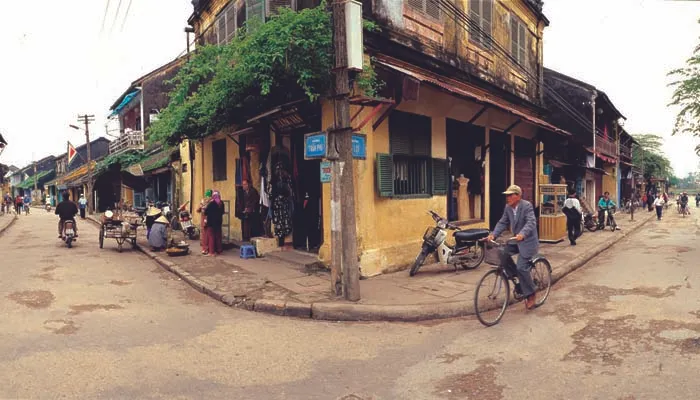
Hoi An's history traces back to prehistoric times when the region was inhabited by local communities and the Champa civilization. The strategic location along the trade route between Haisi Lac Long Quan and Kinh Duong paved the way for the city's emergence as a bustling trading port during the Middle Ages.
Its early cultural exchange with neighboring countries like China, Japan, India, Indonesia, and European nations enriched Hoi An with a unique blend of Eastern and Western influences.
Born in the second half of the 16th century – when Vietnam was under the rule of the Le Dynasty and opened the most prosperous period hundreds of years later. With the coexistence of several civilizations, Hoi An still nearly entirely unaltered today. Hoi An City is famous for its ancient towns with moss-covered red tile roofs -which is known as Pho Co Hoi An. Hoi An ancient town has been recognized by UNESCO as a World Heritage Site since 1999.
Before, The Dong Kinh region was governed by the Mac dynasty after Mac Dang Dung won the Le House in 1527. In 1533, Nguyen Kim on behalf of the Le Dynasty gathered soldiers against the Mac Dynasty.
However, Nguyen Kim passed away in 1545, leaving his son-in-law -Trinh Kiem in charge and the Nguyen Kim family in a desperate situation. Nguyen Hoang, whose Nguyen Kim’s second son, escaped from the Thuan Hoa region in 1558 with his family and some soldiers, and starting in 1570, Nguyen Hoang maintained control over the defense of Quang Nam province.
Together with his son- Nguyen Phuc, they tried to develop the economy of Dang Trong, expanding trade with foreign countries, Hoi An became the busiest international trading port in Southeast Asia at that time.
Thanks to advantageous geographic and climate conditions, hoi An used to be a thriving and bustling international port, a meeting site for merchant ships and merchants from China, Japan, and Western nations throughout the 17th and 18th centuries.
About the name Hoi An. According to Westerners, Hoi An was called Faifo in the past, which means a port town/town. But this is just a name, not considered official, but Hoai Pho is the main name before the name Hoi An is used.
Flourishing Trade and Cultural Exchange
During the Middle Ages, Hoi An flourished as a vibrant hub for international trade and cultural exchange. The city's significance as a major seaport under the Nguyen Dynasty further propelled its prosperity. Local industries thrived, and Hoi An became known for its traditional crafts and architectural marvels.
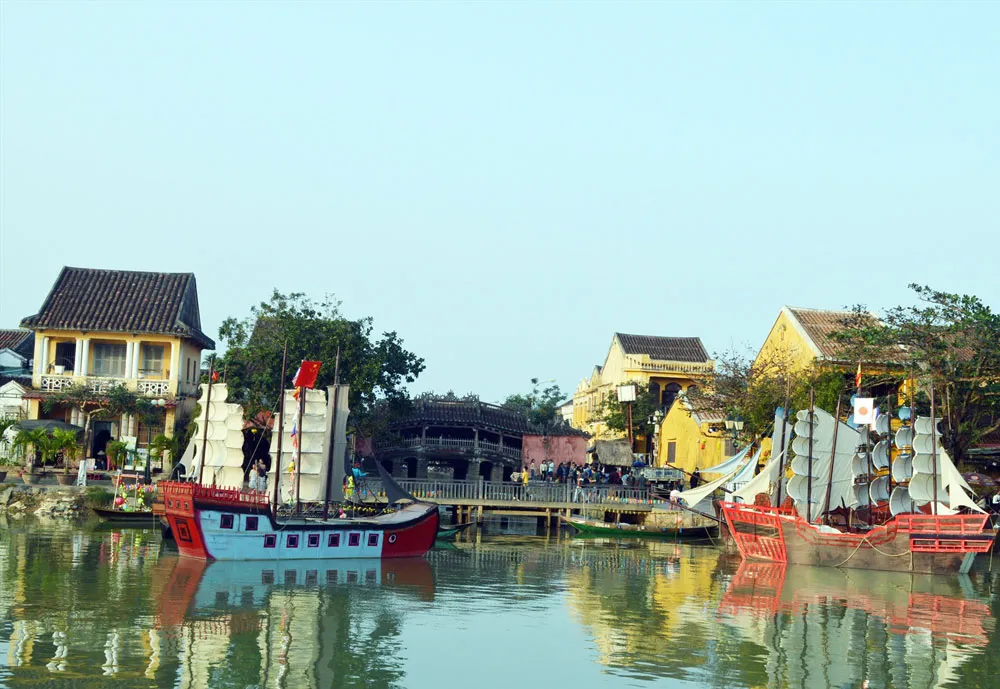
Hoi An culture has the cultural interference of Eastern countries including China, Japan, and Vietnamese culture. There is also the interference between ancient cultures, which is considered a social miniature of three ancient cultures, namely Champa, Sa Huynh, and Dai Viet. However, this place still retains the soul of the Vietnamese people.
In the past, Hoi An ancient town only had one road stretching from Cau Pagoda to Ong Pagoda (located in front of Hoi An market now) and later extended to Ong Bon Pagoda. Hoi An overlooks the Cho Cui River, the name of the Thu Bon River in the early 20th century. Cho Cui has a large trading scale and is a famous landscape comparable to the Marble Mountains.
Japanese Covered Bridge
1. History of Japanese Bridge Hoi An
The Japanese Bridge Hoi An, known as Cau Pagoda (Chùa Cầu), was built in the 17th century with Japanese businessmen’s assistance. As a result, the bridge has been associated with a monster legend called Namazu. Specifically, Namazu is a Japanese mythological monster whose movements cause earthquakes and floods. Its head is located in India, while its body is in Vietnam and its tail is in Japan.
The bridge was built with the belief of a magical sword to pin down Namazu’s back. Therefore, the monster could not wriggle, preventing natural disasters in Vietnam, Japan, and India. Hence, the lives of people in these three countries would be in peace and prosperity.
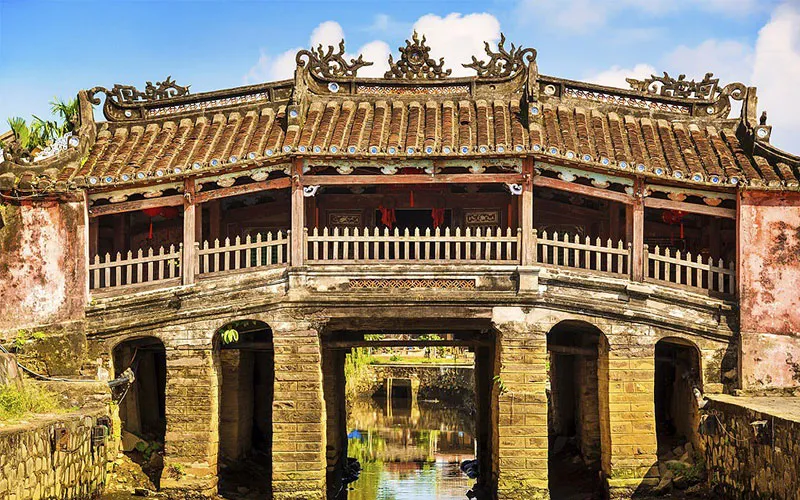
In 1719, Lord Nguyen Phuc Chu visited Hoi An and carved the bridge’s name in 3 Chinese characters on the entrance, which means “Lai Vien Kieu” in Vietnamese and “the bridge to receive guests from afar” in English. Besides, the pagoda was named “Japanese Bridge” or “Japanese Covered Bridge” since it was mainly constructed by Japanese people.
On February 17, 1990, the bridge was recognized as a National Historic – Cultural Heritage Site.
2. The Architecture of the Japanese Bridge
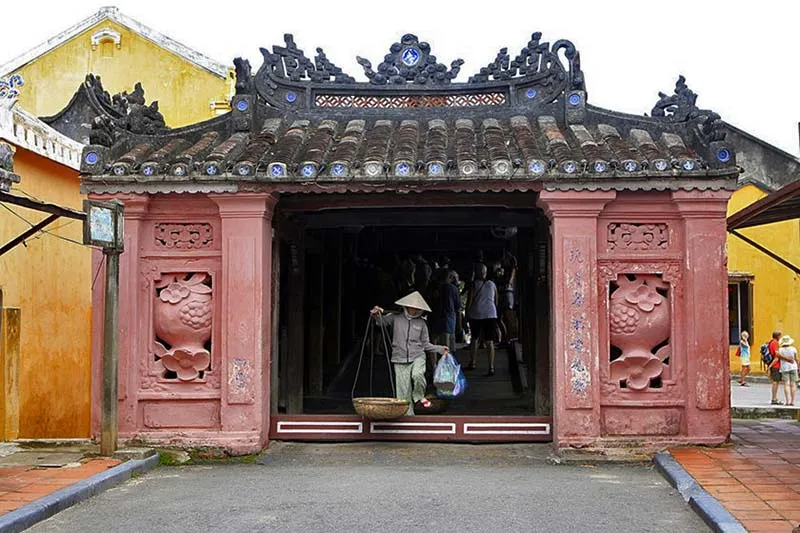
Nguyen Thi Minh Khai Street (the Japanese quarter) on the western side.
The bridge is 18 meters long, connecting Tran Phu Street (the Chinese quarter) on the eastern side and Nguyen Thi Minh Khai Street (the Japanese quarter) on the western side. It crosses the Thu Bon River, bringing a serene and nostalgic atmosphere.
The bridge and the top were built mainly with red lacquered wood, while the base was constructed with stone. Although it is commonly called “Japanese Bridge”, the architecture is an ingenious combination of Vietnamese, Japanese, and Chinese culture, from the material, and design to patterns and decorations.
The bridge highlights the Japanese style with a stunning curved roof, which covers every inch of the bridge. The roof was decorated with yin and yang patterns, which represent Vietnamese culture and architecture.
There are small corridors and benches for visitors to relax and enjoy the pure air on each side of the bridge. The temple is separated from the bridge by a thin wooden wall.
At the entrance and the exit of the bridge, there is a dog and a monkey respectively. They represent the guardians of the bridge since they symbolize protection and safety in Japanese culture. It is also said that these two statues marked the beginning of the construction in the year of Monkey and the completion in the year of Dog.
3. The renovation of the Japanese Bridge
The Japanese Bridge Hoi An has gone through 7 renovations over 400 years, particularly in 1763, 1815, 1875, 1917, 1962, 1986, and 1996. Some small adjustments have been made to the roof, floor, and pillars.
The Minh Huong Commune, a village in Hoi An at that time, was accredited for the first 3 renovations of the bridge. During the French colonial period, the French converted the pedestrian-only bridge into one that supports motorized vehicles in 1917.
.webp)
The bridge has been renovated 7 times (Source: Collected).
In 1962, the Quang Nam provincial government continued to repair the Japanese Bridge. The bridge was restored to its original pedestrian-only design in 1986. The last two renovations in 1986 and 1996 were regarded as the most substantial ones.
The bridge has been downgraded since the last renovation due to various floods in Hoi An City. Many poles and beams that support the bridge have deteriorated, emphasizing urgent maintenance before it collapses.
Therefore, the Quang Nam provincial government approved a nearly one-million-dollar project to preserve the bridge. The actual work started in early 2020, aiming to maintain the bridge’s existence.
4. Interesting Facts about the Japanese Covered Bridge
Unlike other temples, the Cau Pagoda does not worship Buddha but venerates the northern deity Tran Vo Bac De, the god of happiness, wealth, and health in Hoi An. Therefore, the Bridge Pagoda Hoi An is not only a prominent tourist attraction but also a religious site for local people to ease their minds and pray for best wishes.
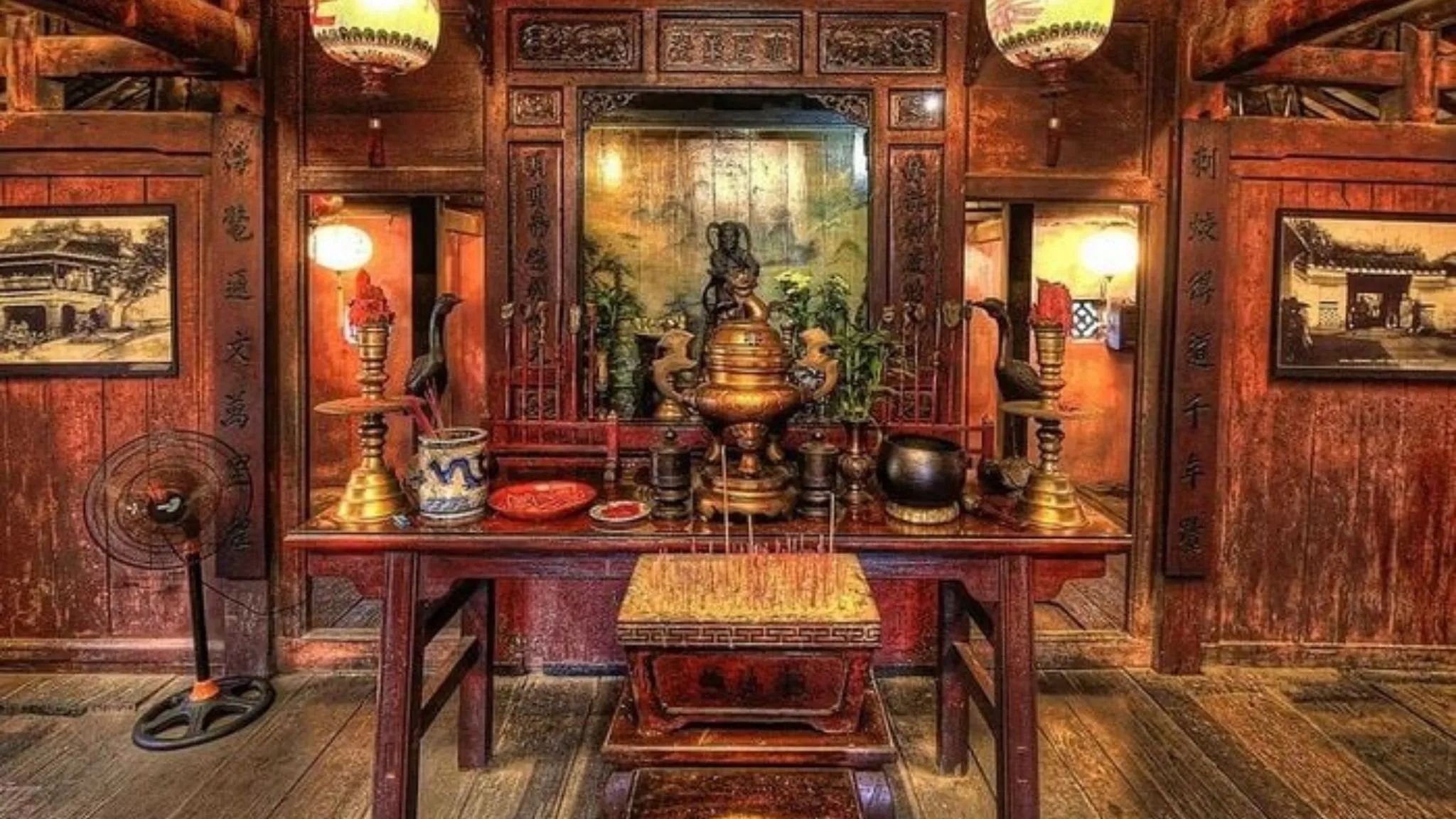
The Cau Pagoda worships the northern deity Tran Vo Bac De (Source: Collected).
The Bridge Pagoda in Hoi An has two distinguished parts: the bridge and the temple. Therefore, it was called “Chua Cau” in Vietnamese (“Chua” = “temple”, “Cau” = “bridge”).

The image of the bridge part of “Chua Cau” (Source: Collected)The image of the bridge part of “Chua Cau” (Source: Collected).
The bridge was built first over the Thu Bon River, while the temple was built 60 years later on the north side of the bridge. Once you decide to visit the monument, you should not miss any of these two places.
Description of Hoi An's Historic Architecture/ The Allure of Hoi An's Charm
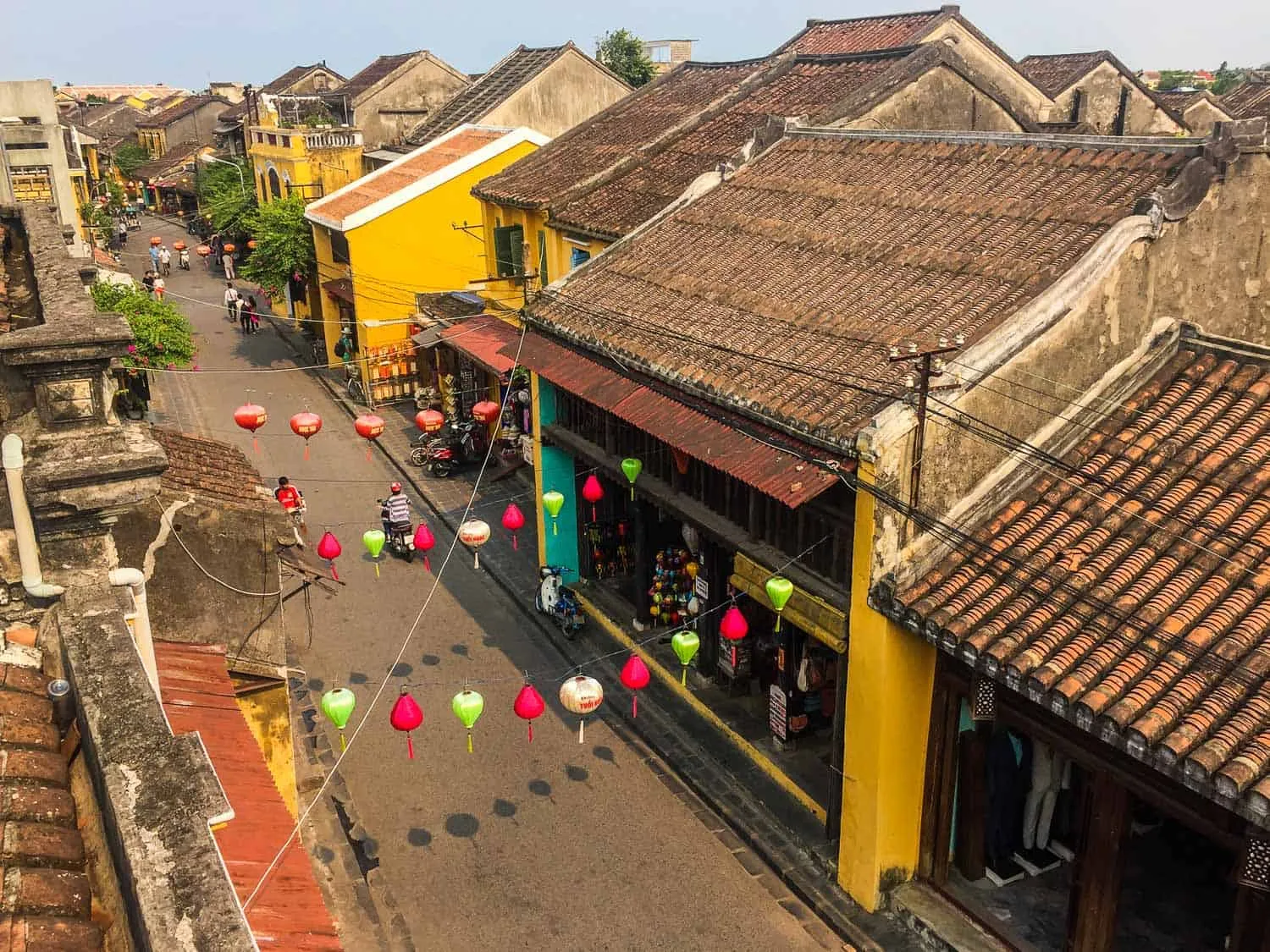
The Allure of Hoi An's Charm (Source: Collected).
Visitors can see a series of old-architectured lanes and houses with nearly 100% pristinely left from their initial buildings with mossgrown walls, deeply plain roofs, old furniture in their cristine past arrangement, etc.
Hoi An is fortunate to be a cultural crossroads of the Cham culture in the very first southward expansion of Dai Viet (the Vietnamese nation more than 5 centuries ago encroaching on the Indianized Kingdom of Champa, which covered much of what is now central Vietnam), the Asian (Japanese, Chinese, Indian), and the Western ones during their trading here in the 16th century.
These diverse cultural influences remain visible today. Colorful guildhalls, founded by ethnic Chinese from Guangdong and Fujian provinces, stand quietly, a testament to the town’s trading roots.
Visitors can see a series of old-architectured lanes and houses with nearly 100% pristinely left from their initial buildings with mossgrown walls, deeply plain roofs, old furniture in their cristine past arrangement, etc.
Hoi An is fortunate to be a cultural crossroads of the Cham culture in the very first southward expansion of Dai Viet (the Vietnamese nation more than 5 centuries ago encroaching on the Indianized Kingdom of Champa, which covered much of what is now central Vietnam), the Asian (Japanese, Chinese, Indian), and the Western ones during their trading here in the 16th century.
These diverse cultural influences remain visible today. Colorful guildhalls, founded by ethnic Chinese from Guangdong and Fujian provinces, stand quietly, a testament to the town’s trading roots.
1. House style in Hoi An
Coming to Hoi An, visitors can easily see one- or two-story townhouses with a narrow width (4-8 m), and very long depth (10-40 m) like a tubular. This is the most common type of house here. Due to the harsh climate, the materials used to build houses have high strength and durability. Normally, houses in the old town will have a wooden frame structure with brick walls on both sides. The layout of the premises will include sidewalks, patios, main houses, outbuildings, toilets, courtyards, three-room rear houses, and back gardens.

You will see pictures of small two-story houses like this one (Source: Collected).
Each house, whether small or large, ensures the harmony of space and nature with bonsai, and rockery, … creating overall beauty. Thanks to the unique architecture, the space of the house is always airy and full of sunlight. Bringing new life to the people and creating excitement for visitors.
2. Mossy roof tiles
All the houses in Hoi An are roofed with tiles, in the form of two roofs. Most of the main houses and outbuildings do not share one roof, but two adjacent roof folds. In contrast, the bridge is roofed in the style of four roofs. Regarding the total card, the front house, the back house, and the toilet are all with separate tile roofs.
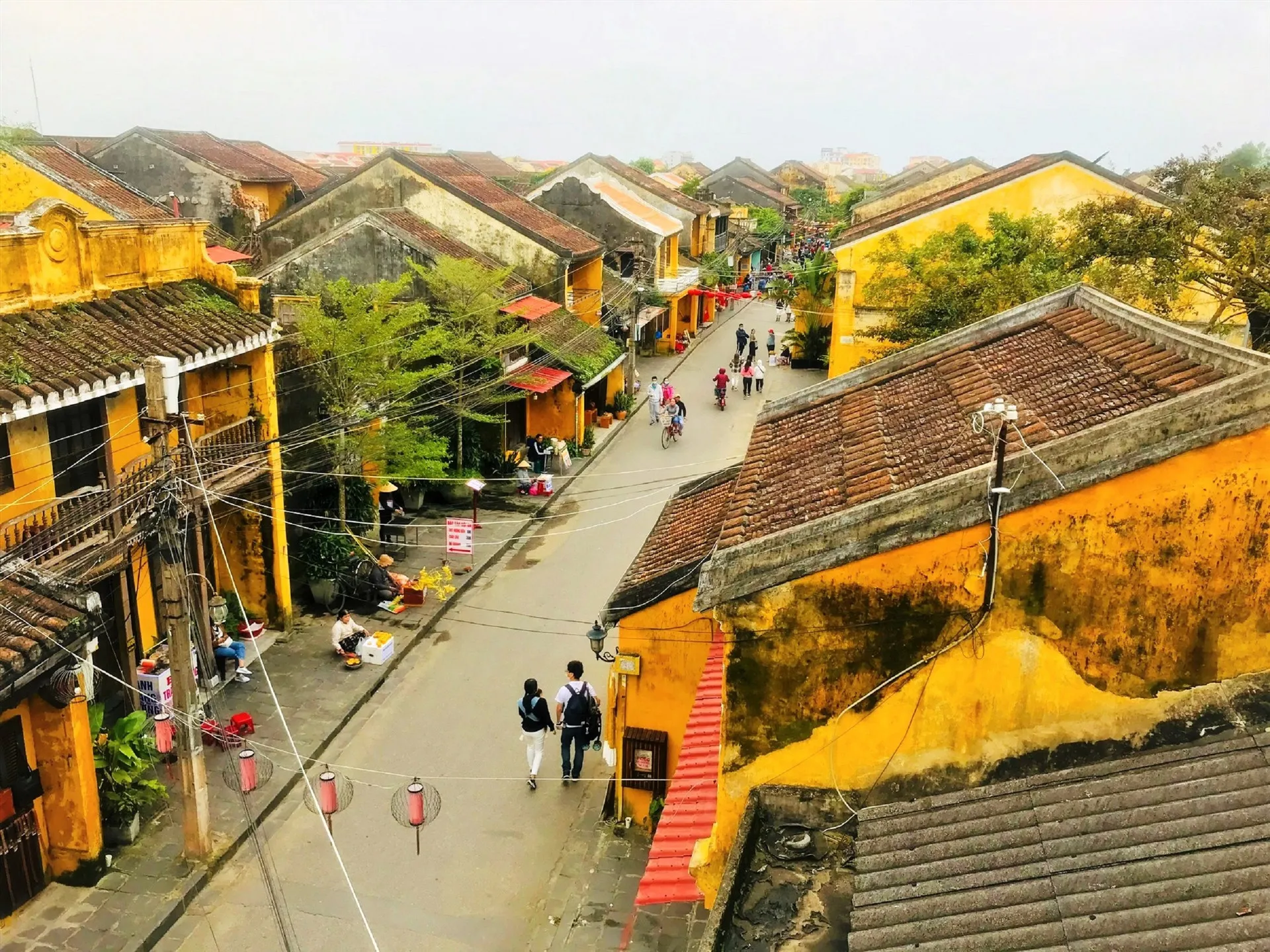
The roofs are covered with moss (Source: Collected).
A special feature is the tile used for roofing in Hoi An is a type of tile made from earth, thin, rough, square, slightly curved, about 22 cm long on each side, and roofed in the yin-yang style. After the roof is finished, the tiles will be fixed with strips of tiles that protrude vertically, increasing the rigidity of the roof. The roof is built high into a rectangular shape. This form and decoration impressed the ancient town of Hoi An.
3. Hoi An Street
The streets themselves constitute a striking feature that imparts a distinct allure to this ancient town. Arranged in a chessboard-like pattern, they stretch horizontally, adorned with picturesque, winding lanes cradling rows of charming houses. Venturing along these quaint pathways, each step unveils a heightened sense of Hoi An's beauty, offering glimpses into the everyday lives of its inhabitants – lives characterized by tranquility and simplicity.
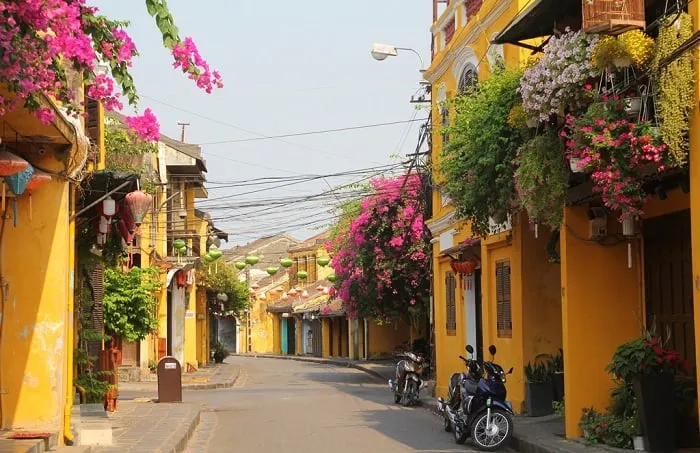
The streets of Hoi An are small but very beautiful (Source: Collected).
Old houses in the old town
1. Tan Ky ancient house

Tan Ky ancient house (Source: Collected).
The Tan Ky ancient house was built nearly 200 years ago, and has a tubular architecture with the interior divided into many compartments, each holding a separate function. The front of the house is used to open a shop, the back side connects to the river wharf as a place to produce and import goods. The materials and interior are mainly wood and are very delicately carved. This old house is honored to become a National Heritage Site and is the only place to receive Heads of State.
2. Phung Hung Ancient House
Located on Nguyen Thi Minh Khai Street, Phung Hung's ancient house with a lifespan of more than 100 years possesses a unique structure which is also an outstanding architectural work of the old town. The house has a high wooden attic and a wide corridor surrounding it, showing the exchange between Asian architectural styles. Here, information about the lifestyle of merchants in the ancient trading port of Hoi An is kept. This ancient house was granted the certificate of historical-cultural relic in June 1993.
3. Hoi An with its assembly halls
- Fukien
Legend has it that this is a small temple built in 1697 to worship Thien Hau Thanh Mau – a statue found on the coast of Hoi An. According to people’s opinion, this is the queen who helps merchants cross the ocean to trade everywhere. Sometime later, the Fujian Assembly Hall was contributed by the overseas Chinese in Hoi An and restored to become the modern assembly hall.
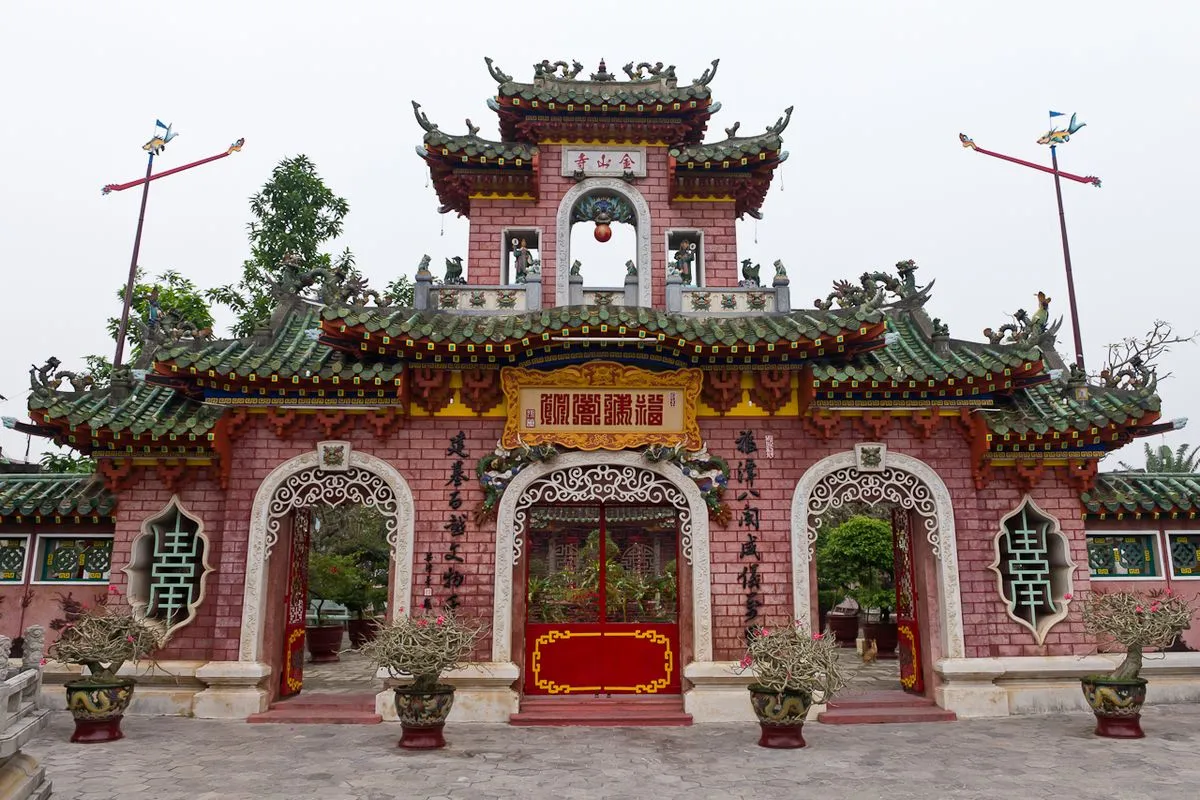
Assembly halls are also a unique feature in architecture (Source: Collected).
- Cantonese Assembly Hall
The Cantonese Assembly Hall was built in 1885 by overseas Chinese. At first, it used to refer to Thien Hau Thanh Mau and Confucius, but after 1911, it changed to worship Tien Hien and Quan Cong. The harmonious combination of wood, stone, and decorative motifs has created a unique beauty for the assembly hall.
- Assembly Hall of Chaozhou
This is also a work worth mentioning when introducing the ancient town of Hoi An. The assembly hall was built in 1845 to worship Phuc Ba General Ma Vien – a god who was good at controlling the waves and helping the traveling and trading of merchants everywhere go smoothly. Similar to the assembly halls in the old town, Trieu Chau has a structure with a finely carved wooden frame and beautiful wood and porcelain motifs.
Old Town and Ancient Town Temple
1. Quan Cong Temple (Ong Pagoda)
This temple was first built in 1653 and has undergone 6 restorations since then. Ong Pagoda has majestic and monumental architecture and is the place to worship the Quan Van Truong statue, so it is also known as Quan Cong Mieu. It is considered the religious center of the people of Quang Nam province in the past and a place where traders often go to pray for good luck.

2. Quan Yin Buddha from Minh Huong
It is the only remaining Buddhist temple in the heart of the old town. Not only has the beautiful architecture and landscape but also preserves almost intact the wooden carvings carved by the artisans of Kim Bong carpentry village in Hoi An. Usually on holidays or full moon days, many people come here to burn incense and pray.
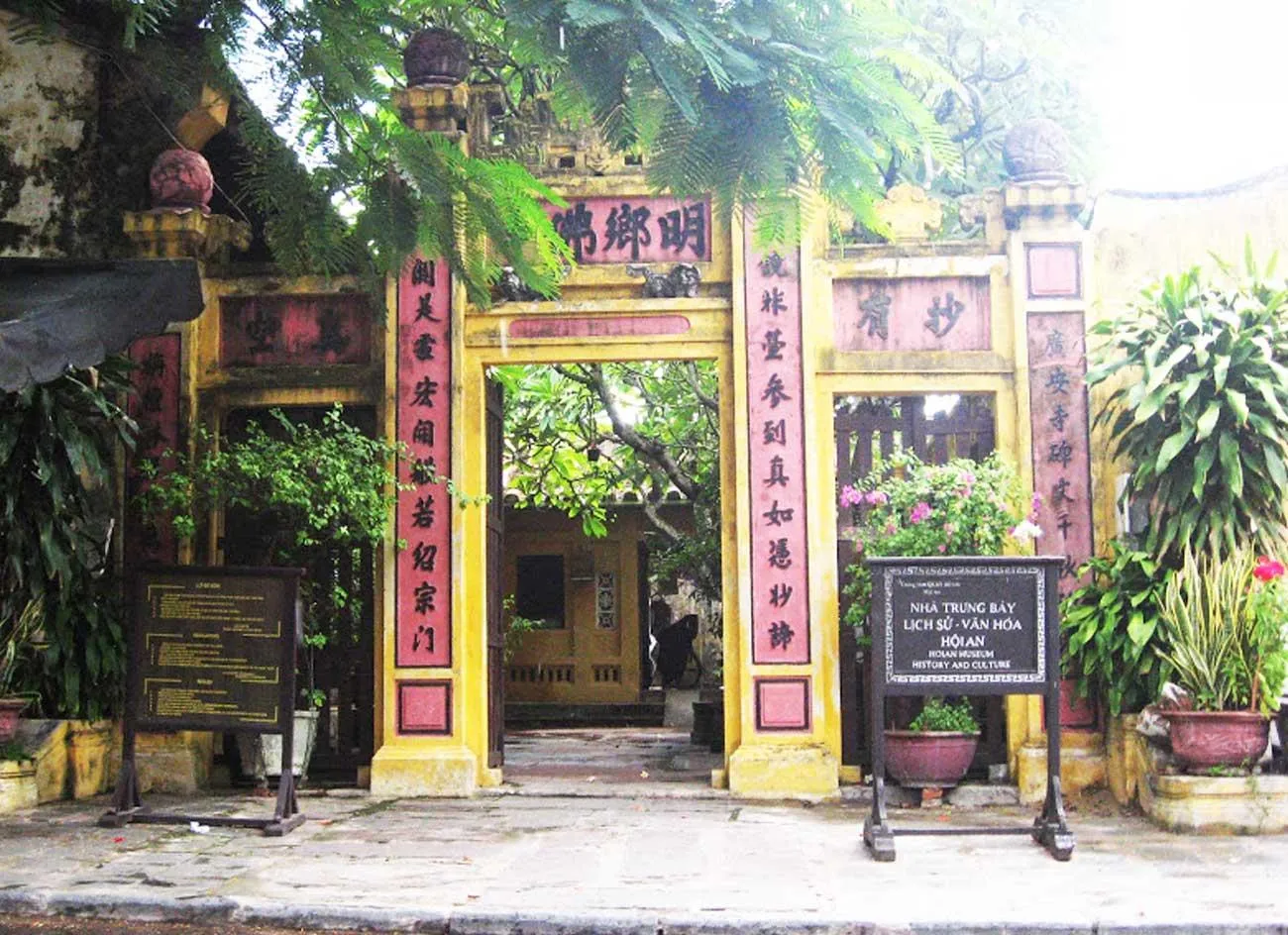
Quan Yin Buddha from Minh Huong (Source: Collected).
3. Church of the Tran family
The Tran family church was built by a Mandarin of the Tran family from China in 1802 according to the feng shui principles of both the Chinese and the Vietnamese. Located on a large area of land with many items: the church of grandparents, the display space of relics related to the family, houses, etc. Coming to Hoi An, visitors should not miss this place if they want to understand more. about ancient culture.
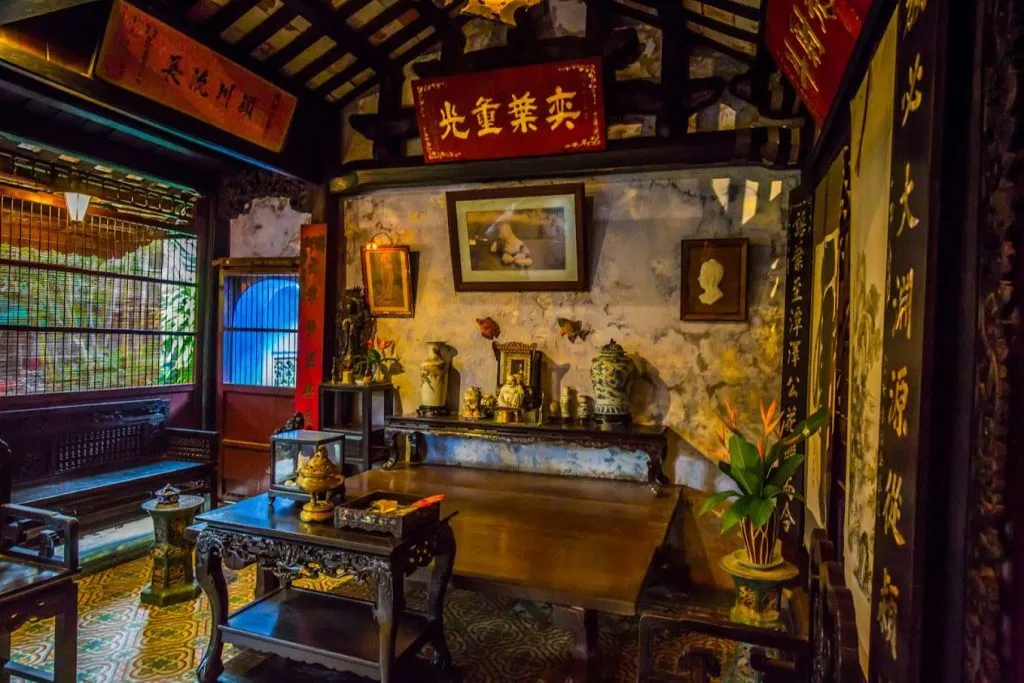
Church of the Tran family (Source: Collected).
Hoi An Museums
1. History and culture museum
The museum, built in 1989, is a place to display 212 original artifacts and documents made of ceramics, bronze, iron, wood, paper, etc. Thereby reflecting the development stages of this urban–trading port throughout the world. 2nd century AD to 2nd century – 15th century and 15th century – 19th century.
2. Museum of Commercial Ceramics
The Museum of Commercial Ceramics is also one of the addresses mentioned in many informational articles about Hoi An ancient town. This is an old house that was restored in 1995 into a museum. The Museum of Ceramics is currently located at 80 Tran Phu, displaying more than 430 artifacts dating from the 8th – 18th centuries. Most of the ceramic samples are from China, Japan, India, and Thailand. , Vietnam, … demonstrate the role of Hoi An in the ceramics trading network at sea.
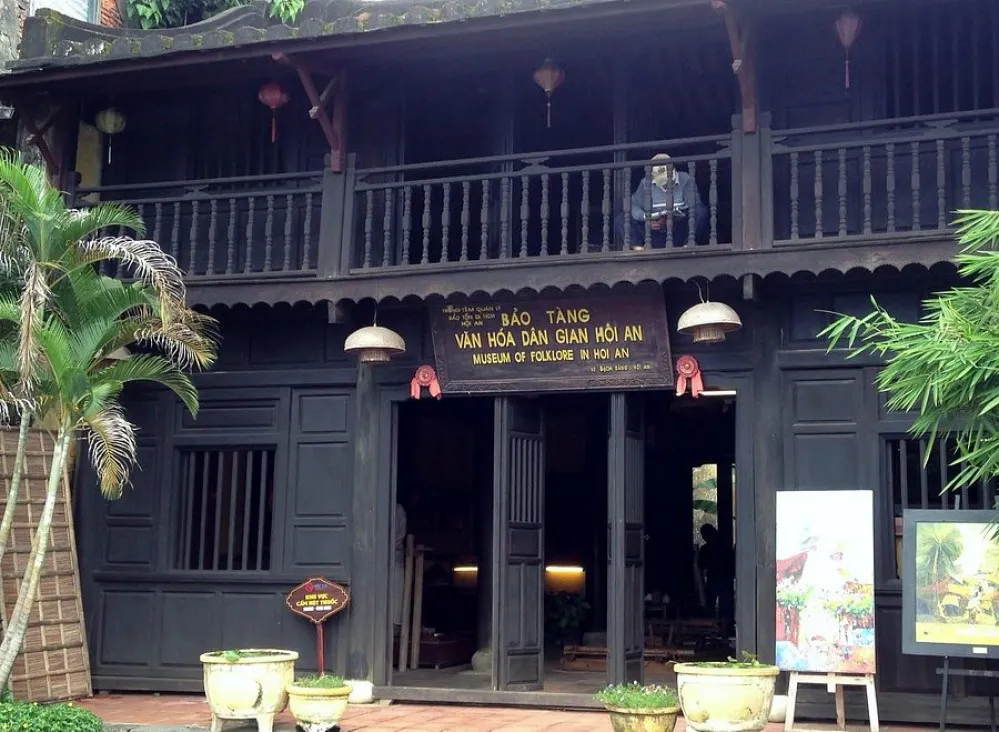
3. Sa Huynh Culture Museum
The place provides quite a lot of information about the inhabitants of Sa Huynh culture – the owner of the commercial port of Hoi An. Currently, the museum displays about 216 artifacts from 2,000 years ago, discovered and deployed from 1959 to 1994. All of them are considered unique and valuable collections of Vietnam today.
4. Hoi An Traditional Medicine Museum
The museum is set up in an old house similar to Hoi An townhouse. This museum has been in operation since mid-March 2019, displaying more than 200 artifacts and documents related to the traditional medical profession. Along with that, there are many special spaces such as The northern medicine sales area, re-inspection area for drying, storing drugs, space for processing some medicines…
Hoi Hoi An has been recognized by UNESCO as a World Cultural Heritage Site
1. Architect Kazimierz Kwiatkowski (1997-2017)- the Knight of Central Vietnam's Heritage
Kazimierz Kwiatkowski (1944 - 1997), also known in Vietnam as architect Kazik, was a Polish architect and conservationist. He is known for his efforts to preserve historical and archaeological sites in Vietnam such as Hue Imperial Citadel, Hoi An, and My Son Sanctuary. Architect Kazik is considered a major contributor to the preservation of historical sites in Vietnam and contributed to bringing these monuments to the list of UNESCO World Heritage Sites.
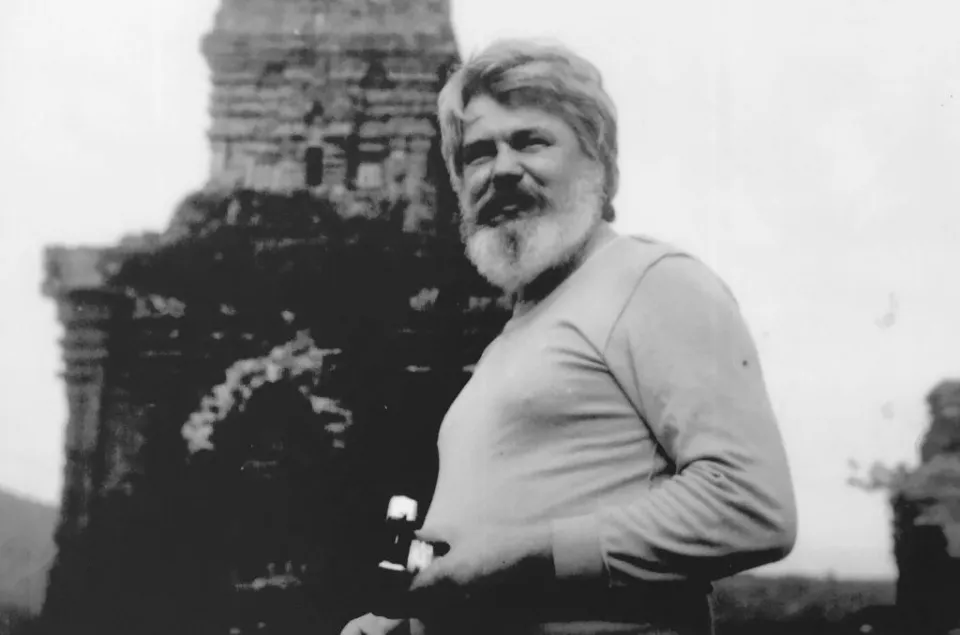
In 1981, he was assigned to lead the restoration mission in the Socialist Republic of Vietnam. The Polish-Vietnamese Monument Restoration Mission is the first project that the Office of Monuments Restoration (PP PKZ) has undertaken in Asia. It was an important challenge for PP PKZ, and Kazimierz Kwiatkowski was the only expert to have accepted the challenge.
He, along with Vietnamese experts, has researched and prepared a program to restore medieval works of the Cham culture in central Vietnam. The mission focused first on the brick worshiping towers at the holy site complex in the Amaravati territory of the ancient Champa kingdom. A "disappearing kingdom" with little history and culture left behind.
He has made efforts to lobby the local government to take measures to preserve and restore the ancient town of Hoi An and at the same time introduce the distinctive features of Hoi An to the world. During the time in My Son, eight people in the archeological team of architect Kazik died from bombs left after the war, due to illness and a miserable life. In 1991, when the financial source for the archaeological activities of the Polish team of experts was terminated, architect Kazik himself called for the creation of funds for his archaeological activities at My Son, even at this time, this most difficult, he still said:
“I can endure anything, as long as I live for the towers.”
Despite objections from some experts, architect Kazik has always pursued the principle of "archaeological" restoration in which the original monument will be preserved to the maximum extent intact, and restoration measures are taken and applied only to maintain the status quo. He was the first to pay attention to the special heritage value of the small town of Hoi An located right next to the ancient port of Faifo of the Cham people. The wooden buildings are still intact, the excellent planning of the city is preserved and the tailoring industry is flourishing in the city. He convinced the Vietnamese government to care about this small city and not to change the buildings toward modernity.
Architect Kazik himself returned to Poland to bring chemicals back to Vietnam to serve in the restoration of My Son. It is thanks to this principle that Hoi An and My Son were later recognized as World Cultural Heritage.
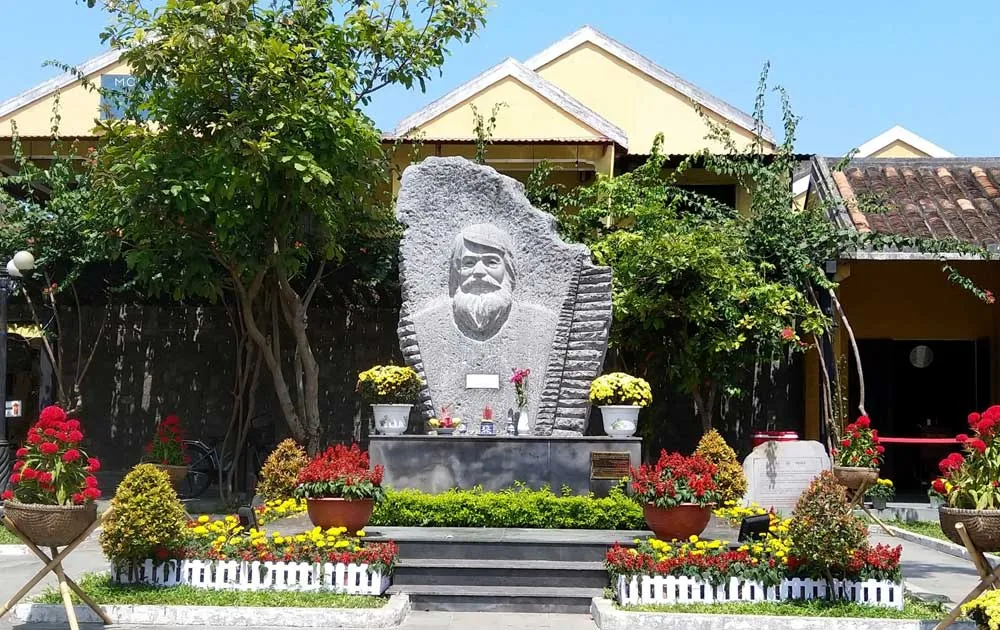
Monument to architect Kazik in Hoi An (Source: Collected).
Architect Kazik is considered a major contributor to making Hoi An and My Son become World Heritage Sites. So in 2007, Hoi An City erected a statue of the architect to commemorate his merits. 2009 another statue commemorating architect Kazik started construction in My Son.
A Tourist Haven
With the title of UNESCO World Cultural Heritage, Hoi An is an ancient town that exudes old beauty over time. In the past, this town was once a prosperous commercial port along the banks of the Thu Bon River in central Vietnam, attracting merchants from all over the world. At present, Hoi An still retains its classic, peaceful, and romantic beauty, as a "living museum" with yellow houses, tiled roofs, and a series of sacred buildings such as communal houses, temples, and pagodas. Chinese restaurant. In particular, the Japanese Covered Bridge is particularly prominent - a unique symbol of Hoi An.
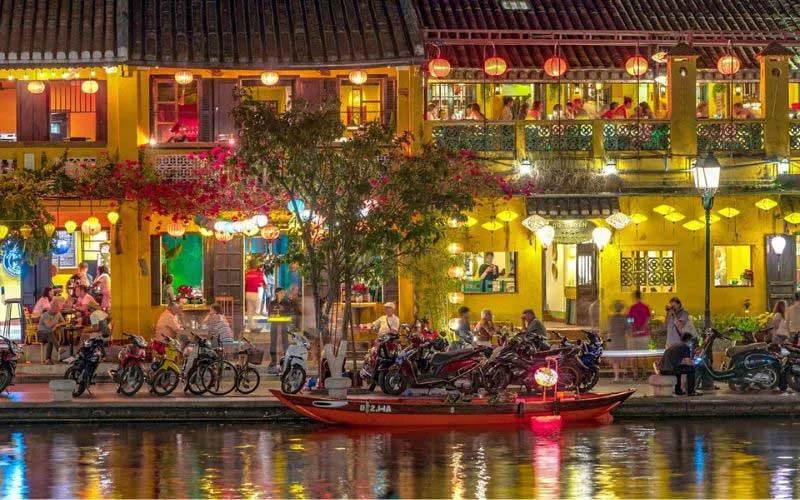
Wanderlust magazine, based on the real experiences of more than 3,000 active British travelers, has conducted a poll of the most favorite cities of the year. Hoi An scored an impressive score with a satisfaction rating of up to 97.18%.
According to the magazine, Hoi An is different from the popular travel to Southeast Asia, with a peaceful and smoke-free space. Traffic is banned in the central area, allowing visitors to relax and admire the pastel-colored houses, blending with the small streets, cafes, markets, tailors, and clothing stores located throughout. old Quarter. The sound of temple bells and the gentle footsteps of visitors are all that permeates the soul here. This is no longer a secret, making Hoi An a favorite destination for many people.
============================================================
Thank you for your watching!
Main contents
- Introduction about Hoi An ancient town is located, in which province?
- The Ancient Roots
- Flourishing Trade and Cultural Exchange
- Japanese Covered Bridge
- Description of Hoi An's Historic Architecture/ The Allure of Hoi An's Charm
- Old houses in the old town
- Old Town and Ancient Town Temple
- Hoi An Museums
- Hoi Hoi An has been recognized by UNESCO as a World Cultural Heritage Site
- A Tourist Haven


